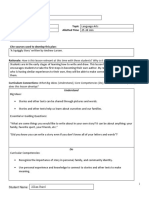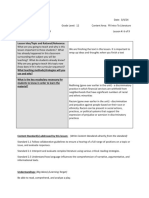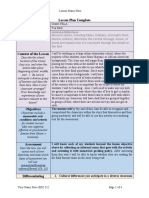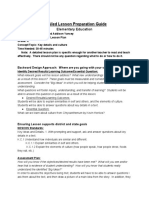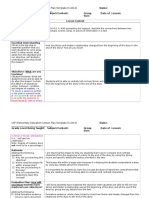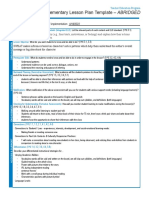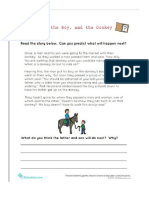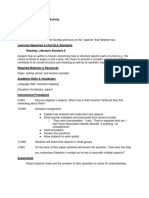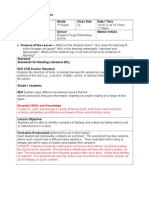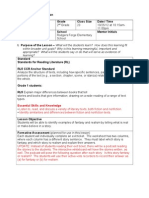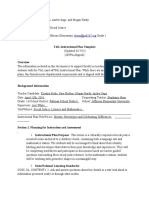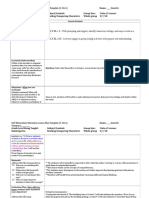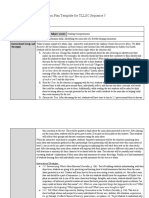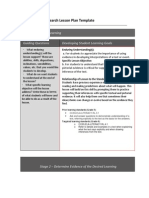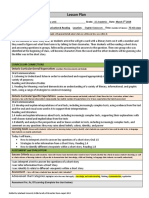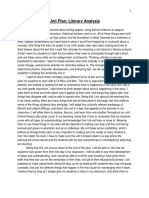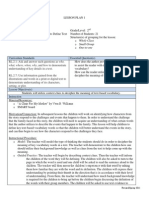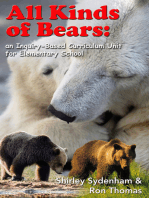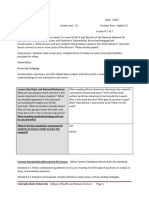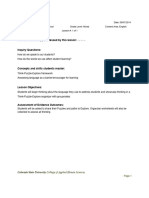CEP Lesson Plan Form: Literacy Standards
CEP Lesson Plan Form: Literacy Standards
Uploaded by
api-707646511Copyright:
Available Formats
CEP Lesson Plan Form: Literacy Standards
CEP Lesson Plan Form: Literacy Standards
Uploaded by
api-707646511Original Title
Copyright
Available Formats
Share this document
Did you find this document useful?
Is this content inappropriate?
Copyright:
Available Formats
CEP Lesson Plan Form: Literacy Standards
CEP Lesson Plan Form: Literacy Standards
Uploaded by
api-707646511Copyright:
Available Formats
CEP Lesson Plan Form
Teacher: Amelia Simmons Date: 2/2/24
School: Rocky Mountain HS Grade Level: 12 Content Area: Short Fiction
Title: Impacts of Identity Lesson #: 1 of ?
Lesson Idea/Topic and Rational/Relevance:
What are you going to teach and why is this
lesson important to these students? What This is the first lesson of Short Fictions’s next unit formed
has already happened in this classroom around the thematic topic of “identity.” To begin thinking
surrounding the subject you will be about themes of identity in our readings, we will first
teaching? What do students already know? look inward and think about our own identities.
Why are you going to teach this topic now
(how does it fit in the curricular sequence)?
What teaching methods/strategy will you
be use and why?
What is the key vocabulary necessary for
students to know in order to learn the
material? Identity
Content Standard(s) addressed by this lesson: (Write Content Standards directly from the standard)
Standard 1.1 Follow collaborative guidelines to ensure a hearing of a full range of positions on a topic or
issue, and evaluate responses.
Standard 2.2 Interpret and evaluate complex informational texts using various critical reading strategies.
Understandings: (Big Ideas)-(Learning Target)
SWBAT connect their own and others’ identities to stories
Literacy Standards:
(Above standard as this is a literacy class)
Colorado State University College of Health and Human Sciences Page 1
CEP Lesson Plan Form
Understandings: (Big Ideas) (Learning Target) (ditto)
(Above standard as this is a literacy class)
Math Standards:
n/a
Understandings: (Big Ideas) (Learning Target)
n/a
Democracy and 21st Century Skills
SWBAT understand identities and the stories and meanings people have with them.
Understandings: (Big Ideas) (Learning Target)
There are many identities a person can hold. Those identities have impacts on how they view the world
and themselves. Identities are a part of people’s stories.
Inquiry Questions: (Essential questions relating knowledge at end of the unit of instruction, select
applicable questions from standard)
How can a persons’s (or my) identity affect their (or my) story?
Evidence Outcomes: (Learning Targets) AND (Success Criteria) Next to each Learning Target OR
Objectives, state how you are addressing literacy AND numeracy within this lesson.
I can: name some of my identities.
This means: I can understand different categories of identities and I can identify what my identity is in
that category.
I can: explain how my name is a part of my identity and story.
This means: I can share a story about my name that brings meaning to my name and becomes a part of
my identity.
Colorado State University College of Health and Human Sciences Page 2
CEP Lesson Plan Form
List of Assessments: (Note whether the assessment is formative or summative?)
Identity wheel - formative - Student is able to identify some of their identities
Name activity - formative - Student is able to explain the meaning behind something that identifies
them.
Colorado State University College of Health and Human Sciences Page 3
CEP Lesson Plan Form
Planned Lesson Activities
Name and Purpose of Lesson
Should be a creative title for you and the Impacts of Identity - This is the first lesson of Short Fictions’s next unit
students to associate with the activity. formed around the thematic topic of “identity.” To begin thinking about
Think of the purpose as the mini-rationale themes of identity in our readings, we will first look inward and think
for what you are trying to accomplish about our own identities.
through this lesson.
Approx. Time and Materials
How long do you expect the activity to last Approx. 45-50 mins
and what materials will you need?
Identity Wheel Papers
- Teacher Example
Small pieces of paper for name activity
Anticipatory Set
The “hook” to grab students’ attention. To start the class, teacher (T) asks: what makes you who you are? Where
These are actions and statements by the do you “fit in,” and how do you know you fit there? T gives students (Ss) a
teacher to relate the experiences of the minute to think on these questions and then begins activity.
students to the objectives of the lesson, To
put students into a receptive frame of mind. Ss watch a video on identity (7 min). After the video, Ss discuss the
● To focus student attention on the contents of the video with the focus question, “Why are people’s and
lesson. your own identities important?”
● To create an organizing framework
for the ideas, principles, or After the discussion, Ss fill out their own identity wheel with T’s as an
information that is to follow example to think through what are some of their identities.
(advanced organizers)
An anticipatory set is used any time a
different activity or new concept is to be
introduced.
How do you intend to engage your The strategy I intend to use is ___video__response_________________
students in thinking during the
Anticipatory Set?
Colorado State University College of Health and Human Sciences Page 4
CEP Lesson Plan Form
Why are you using it at this point in your Video/visuals are often more engaging for students, and for the deep
lesson? thinking of “who am I?” the colorful images and fun sounds are very
helpful for attention.
Procedures
(Include a play-by-play account of what After identifying their own identity, Ss will explore how that identity is
students and teacher will do from the apart of their story. T will read “My Name” from The House on Mango
minute they arrive to the minute they leave Street. (under 2 minutes)
your classroom. Indicate the length of each
segment of the lesson. List actual minutes.) T will pass out small pieces of paper for Ss to write their names on. T says
Indicate whether each is: to Ss that it is their choice how much of their name to write down. First
-teacher input last, first middle last, alternative, etc. Ss will share what name they have
-modeling written down and a story with it to their table mates. Ts will walk around
-questioning strategies and listen to Ss conversations and ask a few to share their stories with the
-guided/unguided: class. As an example, T shares name story.
-whole-class practice
-group practice Ex: My first name, Amelia, is my great-grandmother’s name on my
-individual practice mother’s side. My parents decided on 2 names for their first child; one if
-check for understanding it was a girl, Amelia, and one if it was a boy, Riley. I was a girl, so my
-other parents named me Amelia, but they must have liked Riley so much that
when their second child came around, my sister, they named her Riley.
My last name, Simmons, I learned about from a family tree assignment in
middle school. Most of my dad’s side of the family is German, but there
was one guy who immigrated to the US from Wales, and he is the 5x
great-grandfather that my last name came from.
How do you intend to engage your
students in thinking during the The strategy I intend to use is ___group__share__first____________
PROCEDURE?
It is hard for Ss to share with a whole class first thing. So to soften the
Why are you using it at this point in your blow, Ss share first with their table group. The T can use this as an
lesson? opportunity to make sure at least a few people will share for whole class
shareouts by walking around the classroom and listening to the Ss and
Colorado State University College of Health and Human Sciences Page 5
CEP Lesson Plan Form
telling a few of them, “that’s really good; could you share that with the
class?”
Closure
Those actions or statements by a teacher T asks the class for a few Ss to share their name and story with it.
that are designed to bring a lesson (Hopefully, the plants from earlier do their part.) After some sharing, T
presentation to an appropriate conclusion. will wrap up class by saying,
Used to help students bring things together
in their own minds, to make sense out of “Thank you all for sharing your names and the stories associated with
what has just been taught. “Any Questions? them. These stories we shared with each other are very important
No. OK, let’s move on” is not closure. because they relate to our identities. Identity is powerful. They can make
Closure is used: us feel more connected or divided than anything else. Today is the first
● To cue students to the fact that day of our second short story unit: Identity. To prepare for that, think
they have arrived at an important over your other identities, the ones in the wheel and not on it; what
point in the lesson or the end of a stories do you have to tell from those identities? Have a great weekend!”
lesson.
● To help organize student learning
To help form a coherent picture and to
consolidate.
How do you intend to engage your
students in thinking during CLOSURE? The strategy I intend to use is __Whole__Class__Share_____________
Why are you using it at this point in your Whole class share is really important especially for identity activities
lesson? because of their ability to build classroom culture. It is impossible for
classroom culture to be built if students do not know each other. This
activity gives an opportunity for that without the need to share deep and
traumatic things.
Differentiation:
Ss who need assistance on the writing part of the activities can have a
Differentiation should be “scribe” from one of the teachers write down their ideas verbally.
embedded throughout your whole
lesson!! Subtitles on the video
Colorado State University College of Health and Human Sciences Page 6
CEP Lesson Plan Form
This is to make sure you have met Printed copies of “My Name” will be available for Ss to follow along
the needs of your students on IEPS
or 504
To modify: If the activity is too advanced for
a child, how will you modify it so that they
can be successful?
To extend: If the activity is too easy for a
child, how will you extend it to develop their
emerging skills?
Assessment Reflection: (data
Identity wheel - formative - Student is able to identify some of their
analysis) identities in the categories of the wheels.
How will you know if students met the
learning targets? Write a description of Name activity - formative - Student is able to explain the meaning behind
what you were looking for in each something (their name) that identifies them.
assessment.
Colorado State University College of Health and Human Sciences Page 7
You might also like
- Squiggly Story Lesson PlanDocument6 pagesSquiggly Story Lesson Planapi-385530418100% (1)
- Guest Complaint Handling in Hotel RestaurantDocument15 pagesGuest Complaint Handling in Hotel Restaurantsudip ghimire100% (2)
- Reid Essays On The Intellectual PowersDocument309 pagesReid Essays On The Intellectual PowersAlberto Frigo100% (1)
- Puns Lesson Plan Day 2Document7 pagesPuns Lesson Plan Day 2api-395010751No ratings yet
- 3 4 24Document7 pages3 4 24api-707646511No ratings yet
- Ed 243 Lesson 2 My Monster Mama Loves Me SoDocument3 pagesEd 243 Lesson 2 My Monster Mama Loves Me Soapi-245588668No ratings yet
- Cep Lesson PlanDocument6 pagesCep Lesson Planapi-318256564No ratings yet
- Lesson Plan Template Grade/Content Area Lesson Title State StandardsDocument4 pagesLesson Plan Template Grade/Content Area Lesson Title State Standardsapi-404244796No ratings yet
- Lesson Plan - Grade One Ela - Horton Hears A Who Respect 1Document6 pagesLesson Plan - Grade One Ela - Horton Hears A Who Respect 1api-278392316No ratings yet
- Observation Number 2Document3 pagesObservation Number 2api-357419171No ratings yet
- Reflective Lesson PlanDocument6 pagesReflective Lesson PlanstraitmiNo ratings yet
- LessonplantemplatefamilyDocument2 pagesLessonplantemplatefamilyapi-402336501No ratings yet
- Elm 375 LessonDocument5 pagesElm 375 Lessonapi-314804062No ratings yet
- Lesson Plan Unit/Topic: Date: Key Learning Area: Year Level: OutcomesDocument5 pagesLesson Plan Unit/Topic: Date: Key Learning Area: Year Level: Outcomesapi-156164130No ratings yet
- Lesson Plan: Curriculum ConnectionsDocument8 pagesLesson Plan: Curriculum Connectionsapi-295933754No ratings yet
- Lesson Plan 1 BraneckiDocument12 pagesLesson Plan 1 Braneckiapi-643579652No ratings yet
- Simon and Molly Plus Hester Lesson PlanDocument7 pagesSimon and Molly Plus Hester Lesson Planapi-300269240No ratings yet
- Spring Shellsea Melaratep Elementary Lesson Plan Abridged Original 1 1Document5 pagesSpring Shellsea Melaratep Elementary Lesson Plan Abridged Original 1 1api-667812603No ratings yet
- Lesson PlanDocument11 pagesLesson PlanJes Rea EdubalaNo ratings yet
- Designdocument 2Document4 pagesDesigndocument 2api-582009012No ratings yet
- Lit Lesson Plan HickmanDocument13 pagesLit Lesson Plan Hickmanapi-583080295No ratings yet
- Empathy Lesson PlanDocument4 pagesEmpathy Lesson Planapi-488018586No ratings yet
- Legion Teaching UnitDocument20 pagesLegion Teaching Unitapi-708567937No ratings yet
- Lopez R Sped775 M2lessonplanDocument4 pagesLopez R Sped775 M2lessonplanapi-293988360No ratings yet
- CEP Lesson Plan Form: Colorado State University College of Health and Human SciencesDocument7 pagesCEP Lesson Plan Form: Colorado State University College of Health and Human Sciencesapi-707646511No ratings yet
- Putting It All TogetherDocument14 pagesPutting It All Togetherapi-569001953No ratings yet
- USF Elementary Education Lesson PlanDocument8 pagesUSF Elementary Education Lesson Planapi-280247832No ratings yet
- ELED363 Lesson Plan FR1 REVISEDDocument16 pagesELED363 Lesson Plan FR1 REVISEDejoine1No ratings yet
- ELED363 Lesson Plan FR1 REVISEDDocument10 pagesELED363 Lesson Plan FR1 REVISEDejoine1No ratings yet
- Designdocument 460Document6 pagesDesigndocument 460api-530817479No ratings yet
- Cep Lesson Plan 1Document10 pagesCep Lesson Plan 1api-690650522No ratings yet
- Sheila The Brave Lesson Plan Day2Document7 pagesSheila The Brave Lesson Plan Day2api-301531754No ratings yet
- Grade Language Arts Story Analysis: Ccss - Ela-Literacy.L.8.4Document5 pagesGrade Language Arts Story Analysis: Ccss - Ela-Literacy.L.8.4api-272228988No ratings yet
- 6 8diversitybookreadDocument12 pages6 8diversitybookreadapi-314066493No ratings yet
- Stepp Lesson PlanDocument6 pagesStepp Lesson Planapi-257714008No ratings yet
- Lesson 5Document3 pagesLesson 5api-302454223No ratings yet
- Who Am I Lesson PlanDocument8 pagesWho Am I Lesson PlanMaryAnnAnabeNo ratings yet
- Kristin Miller Ubd InferenceDocument2 pagesKristin Miller Ubd Inferenceapi-176292258No ratings yet
- Intelligence and Creativity Lesson PlanDocument3 pagesIntelligence and Creativity Lesson Planapi-548741425No ratings yet
- 450 Lesson 2Document7 pages450 Lesson 2api-309613026No ratings yet
- USF Elementary Education Lesson Plan Template (S 2014) TennysonDocument7 pagesUSF Elementary Education Lesson Plan Template (S 2014) Tennysonapi-329798996No ratings yet
- Culturally Relevant Lesson PlanDocument4 pagesCulturally Relevant Lesson Planapi-314941135No ratings yet
- Name: Amanda Enos Grade Level Being Taught: K Subject/Content: Writing Group Size: Whole (15) Date of Lesson: 3/7/18Document6 pagesName: Amanda Enos Grade Level Being Taught: K Subject/Content: Writing Group Size: Whole (15) Date of Lesson: 3/7/18api-329929206No ratings yet
- Ela 3 27Document5 pagesEla 3 27api-457318255No ratings yet
- Najiyah Bello - Lesson Plan 2Document15 pagesNajiyah Bello - Lesson Plan 2api-470362666No ratings yet
- CT Obv 2 Whole Group ReadingDocument7 pagesCT Obv 2 Whole Group Readingapi-22742434No ratings yet
- Lesson 6Document2 pagesLesson 6api-273233127No ratings yet
- Bridging: MSMU Lesson Plan FormatDocument8 pagesBridging: MSMU Lesson Plan Formatapi-547294586No ratings yet
- Lesson Plan Molly Lou MelonDocument4 pagesLesson Plan Molly Lou Melonapi-404491569No ratings yet
- Lesson Study First LessonDocument8 pagesLesson Study First Lessonapi-270016695No ratings yet
- Lesson Idea/Topic and Rational/Relevanc E: What Are You: CEP Lesson Plan FormDocument8 pagesLesson Idea/Topic and Rational/Relevanc E: What Are You: CEP Lesson Plan Formapi-353478397No ratings yet
- Planning & Assessment CommentaryDocument14 pagesPlanning & Assessment Commentarycbieber2No ratings yet
- Short Story Lesson PlanDocument3 pagesShort Story Lesson Planapi-449656775No ratings yet
- Cooperative Learning Lesson Plan Edu 220 4-10-2022Document7 pagesCooperative Learning Lesson Plan Edu 220 4-10-2022api-570743058No ratings yet
- Design Document For Lesson Plan Elm 375Document4 pagesDesign Document For Lesson Plan Elm 375api-582043330No ratings yet
- Unit Plan Assignment 2Document13 pagesUnit Plan Assignment 2api-313149031No ratings yet
- Sheila The Brave Lesson Plan Day1Document7 pagesSheila The Brave Lesson Plan Day1api-301531754No ratings yet
- 1st Lesson Plan... The Community Garden..Document6 pages1st Lesson Plan... The Community Garden..OvalCatNo ratings yet
- Unit Plan Lesson 5Document3 pagesUnit Plan Lesson 5api-337406556100% (1)
- Literacy UnitDocument8 pagesLiteracy Unitapi-290965174No ratings yet
- CT Obv Lesson Plan 1Document6 pagesCT Obv Lesson Plan 1api-22742434No ratings yet
- Teacher's Guide for My First Acting SeriesFrom EverandTeacher's Guide for My First Acting SeriesRating: 5 out of 5 stars5/5 (1)
- A Raisin in The Sun Anticipation Guide - Google DocsDocument2 pagesA Raisin in The Sun Anticipation Guide - Google Docsapi-707646511No ratings yet
- Educ 450 - Id Lesson Plan 1Document6 pagesEduc 450 - Id Lesson Plan 1api-707646511No ratings yet
- Educ 450 - Classroom Expectations Management PlanDocument5 pagesEduc 450 - Classroom Expectations Management Planapi-707646511No ratings yet
- Educ 450 - Tpe Lesson PlanDocument3 pagesEduc 450 - Tpe Lesson Planapi-707646511No ratings yet
- Educ 450 - Lesson Plan 1Document8 pagesEduc 450 - Lesson Plan 1api-707646511No ratings yet
- The Melody Phrasing CurveDocument134 pagesThe Melody Phrasing CurveFred Fredericks100% (1)
- Focus4 2E Vocabulary Quiz Unit5 GroupADocument1 pageFocus4 2E Vocabulary Quiz Unit5 GroupATim ShelestnoiNo ratings yet
- Sabre Tooth CurriculumDocument6 pagesSabre Tooth CurriculumRoss Chandler Joseph Mosby50% (2)
- Rizal's Life: Higher Education, Life Abroad and Romances (QUIZ #2)Document3 pagesRizal's Life: Higher Education, Life Abroad and Romances (QUIZ #2)Shara Lou ReyesNo ratings yet
- Roccocco New York HotelDocument11 pagesRoccocco New York Hotelnadmoodley100% (1)
- Vietnam - England-Thailand-Japan: Cross-Cultural Communication With Reference ToDocument18 pagesVietnam - England-Thailand-Japan: Cross-Cultural Communication With Reference ToVy NguyễnNo ratings yet
- BA (Hons) Interior Design - DMU: Student Name: Formatively Assessed: Formative Assessment By: Student NumberDocument3 pagesBA (Hons) Interior Design - DMU: Student Name: Formatively Assessed: Formative Assessment By: Student Numberdouglasonyari61No ratings yet
- Requirements of An Acceptable Method of Classification: Figure 3-1Document1 pageRequirements of An Acceptable Method of Classification: Figure 3-1rozi piresNo ratings yet
- Lesson Plan in Tegr 114 (Catacutan, Reina) BEED3BDocument6 pagesLesson Plan in Tegr 114 (Catacutan, Reina) BEED3BReina Rowena Cadungog CatacutanNo ratings yet
- Advantages and Disadvantages of Internet Cafes To The Academic Life of The StudentsDocument16 pagesAdvantages and Disadvantages of Internet Cafes To The Academic Life of The StudentsRobina Kris TibigNo ratings yet
- In Whose NameDocument22 pagesIn Whose NameStephen ScheidellNo ratings yet
- A Case Study of Cognitive Behavioural Therapy For Social Anxiety 750Document6 pagesA Case Study of Cognitive Behavioural Therapy For Social Anxiety 750valeriaNo ratings yet
- Dof Hseq Workbook WebDocument180 pagesDof Hseq Workbook WebvhlactaotaoNo ratings yet
- Thesis About Power and AuthorityDocument5 pagesThesis About Power and Authoritydnnpkqzw100% (2)
- Vachanamrut Study AppDocument21 pagesVachanamrut Study AppKaruna GuhaNo ratings yet
- Wolters 2003Document63 pagesWolters 2003Esih SukaesihNo ratings yet
- Result of DYC of Ist Batch 29.01.2019Document951 pagesResult of DYC of Ist Batch 29.01.2019Atul BajpaiNo ratings yet
- Dr. Joseph Berlin P. Juanzon: Ce, Mba, MSCMDocument18 pagesDr. Joseph Berlin P. Juanzon: Ce, Mba, MSCMGlenn Midel Delos SantosNo ratings yet
- Pinheiro 2014Document7 pagesPinheiro 2014angieNo ratings yet
- UnderstandDocument1 pageUnderstandbwlhytrqyt054No ratings yet
- Lee Hammer Gamification Education 2011Document6 pagesLee Hammer Gamification Education 2011F. Cida100% (1)
- Pakistan Studies Assignment#2: Social Media: A Source of Information or DisinformationDocument4 pagesPakistan Studies Assignment#2: Social Media: A Source of Information or DisinformationAbdul HaadiNo ratings yet
- Breakthrough Leadership TransformingDocument48 pagesBreakthrough Leadership TransformingGeorge Marchan100% (1)
- 2 Communication ModelsDocument36 pages2 Communication ModelsKent DosejoNo ratings yet
- Yayasan Sasmita Jaya: Universitas Pamulang English Letters DepartmentDocument3 pagesYayasan Sasmita Jaya: Universitas Pamulang English Letters DepartmentBima PrawiraNo ratings yet
- Erotic CapitalDocument20 pagesErotic CapitalVanessa GuadagniniNo ratings yet
- Eckhard Hess & Slobodan Petrovich - Ethology and Attachment: A Historical PerspectiveDocument6 pagesEckhard Hess & Slobodan Petrovich - Ethology and Attachment: A Historical PerspectiveIrving Pérez MéndezNo ratings yet
